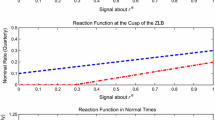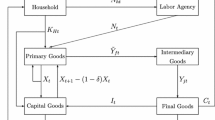Abstract
This paper examines the outcomes of alternative policy targets for monetary policy in an open economy subject to terms of trade shocks and with less-than-perfect exchange-rate pass through. The central bank also learns the evolution of inflation and output growth in the design of its policy rules. We show that a Taylor rule for the interest rate, based on inflation and output gap targets, when terms of trade shocks are positive, yields more beneficial welfare distributions than comparable feedback rules based only on an inflation target.
Similar content being viewed by others
References
Betts, C. and Devereux, M.B. (1996). The exchange rate in a model of pricing-to-market. European Economic Review, 40, 1007–1021.
Betts, C. and Devereux, M.B. (2000). Exchange rate dynamics in a model of pricing-to-market. Journal of International Economics, 50, 215–244.
Blanchard, O.J. and Fischer, S. (1989). Lectures on Macroeconomics. MIT Press, Cambridge, Mass.
Blinder, A. (1998). Central Banking in Theory and Practice. Cambridge, Mass.: MIT Press.
Bray, M.M. and Savin, N.E. (1986). Rational expectations equilibria, learning, and model specification. Econometrica, 54, 1129–1160.
Bullard, J. and Metra, K. (2002). Learning about monetary policy rules. Journal of Monetary Economics, 49, 1105–1129.
Campa, J.M. and Goldberg, L.S. (2002). Exchange rate pass-throuth into import prices: A Macro or Micro Phenomenon?”. NBER Working Paper 8934.
Clarida, R. Gali, J. and Gertler, M. (2001). Optimal monetary policy in open versus closed economies: An integrated approach. American Economic Review, May, 248–252.
Canzoneri, M.B., Cumby, R.E. and Diba, B.T. (2002). Recent Developments in the Macroeconomic Stabilization Literature: Is Price Stability a Good Stabilization Strategy?”. Working Paper, Georgetown University, Department of Economics.
Den Hann, W. and Marcet, A. (1990). Solving the stochastic growth model by parameterizing expectations. Journal of Business and Economic Statistics, 8, 31–34.
Den Hann, W. and Marcet, A. (1994). Accuracy in simulations. Review of Economic Studies, 61, 3–17.
Duffy, J. and McNelis, P.D. (2001). Approximating and Simulating the Stochastic Growth Model: Parameterized Expectations, Neural Networks and the Genetic Algorithm. Journal of Economic Dynamics and Control, 25, 1273–1303.
Devereux, M.B. (2001). Monetary Policy, Exchange Rate Flexibility, and Exchange Rate Pass Through” Working Paper, Department of Economics, University of British Columbia.
Judd, J.F. and Rudebusch, G.D. (1998). Taylor's rule and the Fed: 1970–1997. Federal Reserve Bank of San Francisco Economic Review, 3, 3–16.
Judd, K.L. (1996). Approximation, perturbation, and projection methods in economic analysis. in H.M. Amman, D.A. Kendrick and J. Rust, (eds), Handbook of Computational Economics, Volume I. Amsterdam: Elsevier Science B.V.
Judd, K.L. and Gaspar, J. (1996). Solving Large Scale Rational Expectations Models. Macroeconomic Dynamics, 1, 45–75.
Kim, S. H. and Kose, M.A. (2001). Dynamics of Open Economy Business. Cycle Methods: Understanding the Role of the Discount Factor”. Working Paper, Graduate School of International Economics and Finance, Brandeis University.
Mankiw, N.G. and Reis, R. (2002). Sticky Information vs. Sticky Prices: A Proposal to Replace the New Keynesian Phillips Curve”. Quarterly Journal of Economics, 2002, November, 1295–1328.
Marcet, A. (1988). Solving Nonlinear Models by Parameterizing Expectations. Working Paper, Graduate School of Industrial Administration, Carnegie Mellon University.
Marcet, A. (1993). Simulation Analysis of Dynamic Stochastic Models: Applications to Theory and Estimation, Working Paper, Department of Economics. Universitat Pompeu Fabra:
Marcet, A. and Nicolini J.P. (1997). Recurrent hyperinflations and learning. working paper, American Economic Review. 93(5) 1476–1498.
Mendoza, E.G. (1995). The terms of trade, the real exchange rate, and economic fluctuations. International Economic Review, 36, 101–137.
Mendoza, E.G. (2000). Credit, Prices and Crashes: Business Cycles with a Sudden Stop. Working Paper, Department of Economics, Duke University.
Orphanides, A. and Williams, J.C. (2002). Imperfect knowledge, inflation expectations, and monetary policy. Working Paper, Research Department, Board of Governors of the Federal Reserve System.
Razin, A. (2005). Globalization and Disinflation: A Note. Working Paper No. 4826, Center for Economic Policy Research.
Rotemberg, J. and Woodford, M. (1998). An Optimization Based Econometric: Framework for the Evaluation of Monetary Policy: Expanded Version”. NBER Technical Paper No. 233.
Sargent, T.J. (1999). The Conquest of American Inflation. Princeton, N.J.: Princeton University Press.
Schmitt-Grohé, S. and Uribe, M. (2003). Closing small open economy models. Journal of International Economics, 61, 163–185.
Schmitt-Grohé, S. (2004), “Optimal Simple and Implementable Monetary and Fiscal Rules, Web page: www.econ.duke.edu/uribe.
Taylor, J.B. (1993). Discretion versus policy rules in practice. Carnegie-Rochaster Conference Series on Public Policy, 39, 195-214.
Taylor, J.B. (1999). The robustness and efficiency of monetary policy rules as guidelines for interest rate setting by the european central bank. Journal of Monetary Economics, 43, 655–679.
Taylor, J.B. (2000), Using Monetary Policy Rules in Emerging Market Economies. Manuscript, Department of Economics, Standford University.
Wright, B.D. and Williams J.C. (1982). The economic role of commodity storage. Economic Journal, 92, 596–614.
Wright, B.D. (1984). The welfare effects of the introduction of storage. Quarterly Journal of Economics, 99, 169–182.
Uzawa, H. (1968). Time Preference, The Consumption Function, and Optimum Asset Holdings. In J.N. Wolfe, editor, Value, Capital and Growth: Papers in Honor of Sir John Hicks. Edingburgh: University of Edingburgh Press.
Author information
Authors and Affiliations
Corresponding author
Additional information
JEL classification: E5, F4
Rights and permissions
About this article
Cite this article
Lim, G.C., Mcnelis, P.D. Central Bank Learning and Taylor Rules with Sticky Import Prices. Comput Econ 28, 155–175 (2006). https://doi.org/10.1007/s10614-006-9037-3
Received:
Accepted:
Published:
Issue Date:
DOI: https://doi.org/10.1007/s10614-006-9037-3




